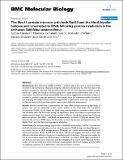Files in this item
The Mre11 protein interacts with both Rad50 and the HerA bipolar helicase and is recruited to DNA following gamma irradiation in the archaeon Sulfolobus acidocaldarius
Item metadata
| dc.contributor.author | Quaiser, Achim | |
| dc.contributor.author | Constantinesco, Florence | |
| dc.contributor.author | White, Malcolm F | |
| dc.contributor.author | Forterre, Patrick | |
| dc.contributor.author | Elie, Christiane | |
| dc.date.accessioned | 2010-10-14T10:12:26Z | |
| dc.date.available | 2010-10-14T10:12:26Z | |
| dc.date.issued | 2008-02-22 | |
| dc.identifier | 617541 | |
| dc.identifier | 3e04ad6b-e9b0-46dc-9b23-8fcc681c7680 | |
| dc.identifier | 000254712300001 | |
| dc.identifier | 41749101058 | |
| dc.identifier.citation | Quaiser , A , Constantinesco , F , White , M F , Forterre , P & Elie , C 2008 , ' The Mre11 protein interacts with both Rad50 and the HerA bipolar helicase and is recruited to DNA following gamma irradiation in the archaeon Sulfolobus acidocaldarius ' , BMC Molecular Biology , vol. 9 , 25 . https://doi.org/10.1186/1471-2199-9-25 | en |
| dc.identifier.issn | 1471-2199 | |
| dc.identifier.other | ORCID: /0000-0003-1543-9342/work/47136120 | |
| dc.identifier.uri | https://hdl.handle.net/10023/1027 | |
| dc.description.abstract | Background: The ubiquitous Rad50 and Mre11 proteins play a key role in many processes involved in the maintenance of genome integrity in Bacteria and Eucarya, but their function in the Archaea is presently unknown. We showed previously that in most hyperthermophilic archaea, rad50-mre11 genes are linked to nurA encoding both a single-strand endonuclease and a 5' to 3' exonuclease, and herA, encoding a bipolar DNA helicase which suggests the involvement of the four proteins in common molecular pathway(s). Since genetic tools for hyperthermophilic archaea are just emerging, we utilized immuno-detection approaches to get the first in vivo data on the role(s) of these proteins in the hyperthermophilic crenarchaeon Sulfolobus acidocaldarius. Results: We first showed that S. acidocaldarius can repair DNA damage induced by high doses of gamma rays, and we performed a time course analysis of the total levels and sub-cellular partitioning of Rad50, Mre11, HerA and NurA along with the RadA recombinase in both control and irradiated cells. We found that during the exponential phase, all proteins are synthesized and display constant levels, but that all of them exhibit a different sub-cellular partitioning. Following gamma irradiation, both Mre11 and RadA are immediately recruited to DNA and remain DNA-bound in the course of DNA repair. Furthermore, we show by immuno-precipitation assays that Rad50, Mre11 and the HerA helicase interact altogether. Conclusion: Our analyses strongly support that in Sulfolobus acidocaldarius, the Mre11 protein and the RadA recombinase might play an active role in the repair of DNA damage introduced by gamma rays and/or may act as DNA damage sensors. Moreover, our results demonstrate the functional interaction between Mre11, Rad50 and the HerA helicase and suggest that each protein play different roles when acting on its own or in association with its partners. This report provides the first in vivo evidence supporting the implication of the Mre11 protein in DNA repair processes in the Archaea and showing its interaction with both Rad50 and the HerA bipolar helicase. Further studies on the functional interactions between these proteins, the NurA nuclease and the RadA recombinase, will allow us to define their roles and mechanism of action. | |
| dc.format.extent | 10 | |
| dc.format.extent | 738942 | |
| dc.language.iso | eng | |
| dc.relation.ispartof | BMC Molecular Biology | en |
| dc.subject | Strand break repair | en |
| dc.subject | Hyperthermophilic archaeon | en |
| dc.subject | Homologous recombination | en |
| dc.subject | Pyrococcus-furiosus | en |
| dc.subject | Escherichia-coli | en |
| dc.subject | Thermophilic archaea | en |
| dc.subject | Ionizing-radiation | en |
| dc.subject | Chromosome segregation | en |
| dc.subject | Genetic-recombination | en |
| dc.subject | Replication forks | en |
| dc.subject | QH426 Genetics | en |
| dc.subject.lcc | QH426 | en |
| dc.title | The Mre11 protein interacts with both Rad50 and the HerA bipolar helicase and is recruited to DNA following gamma irradiation in the archaeon Sulfolobus acidocaldarius | en |
| dc.type | Journal article | en |
| dc.contributor.institution | University of St Andrews. School of Biology | en |
| dc.contributor.institution | University of St Andrews. Biomedical Sciences Research Complex | en |
| dc.identifier.doi | 10.1186/1471-2199-9-25 | |
| dc.description.status | Peer reviewed | en |
| dc.identifier.url | http://www.scopus.com/inward/record.url?scp=41749101058&partnerID=8YFLogxK | en |
This item appears in the following Collection(s)
Items in the St Andrews Research Repository are protected by copyright, with all rights reserved, unless otherwise indicated.

